Responses of Vegetation Phenology to Urbanisation and Natural Factors along an Urban-Rural Gradient: A Case Study of an Urban Agglomeration on the Northern Slope of the Tianshan Mountains
Abstract
1. Introduction
2. Study Area and Data
2.1. Study Area
2.2. Data and Processing
3. Methods
3.1. Urban-Rural Dichotomy
3.1.1. Determining Urban-Rural Boundaries
3.1.2. Differences in Vegetation Phenology between Urban and Rural Gradients and SUHII
3.2. Average Annual Rate of Urban Expansion
3.3. Statistical Analysis
3.4. Detection of Interaction Factors
3.5. Principal Component Analysis and Variance Contribution Rate
4. Results and Analysis
4.1. Spatial and Temporal Evolutionary Characteristics of Vegetation Phenology
4.2. Spatial and Temporal Distribution Characteristics of Diurnal SUHII
4.3. Response of Vegetation Phenology to Urbanisation
4.3.1. Responses of Vegetation Phenology to Urban Economy and Population Size
4.3.2. Response of Vegetation Phenology to the Scale of Urban Expansion
4.3.3. Response of Vegetation Phenology to the SUHI Effect
4.4. Responses of Vegetation Phenology to Natural Factors
4.4.1. Response of Vegetation Phenology to Precipitation
4.4.2. Response of Vegetation Phenology to Temperature
4.4.3. Response of Vegetation Phenology to Elevation
5. Discussion
5.1. Interaction Effects of Urbanisation and Natural Factors on Vegetation Phenology
5.2. Contributions of Urbanisation and Natural Factors to Vegetation Phenology
5.3. Uncertainty Analysis
6. Conclusions
- The vegetation phenological variables in the study area showed pronounced differences across the spatial gradients between urban and rural areas. The closer it was to the urban centre, the earlier the start of the growing season was, the later its end was, and the longer the growing season was. The intensity of the heat island varied significantly among the three urban clusters. The intensity of the SUHII was highest in the Urumqi-Changji region.
- The heat island effect of the urban agglomerations in the study area influenced the spatiotemporal patterns of the surrounding vegetation phenology; however, there was some variability in the effects of the three urbanisation levels on the surrounding vegetation phenology. The urbanisation level of the urban clusters was negatively correlated with SOS but positively correlated with EOS and GSL. The urbanisation level of the Urumqi-Changji district was high and highly influenced the vegetation phenology. The increased fraction of built-up land area delayed SOS, advanced EOS, and lengthened GSL in urban centres. The SUHII value of the urban cluster was significantly correlated negatively with SOS but highly and positively with ΔEOS and ΔGSL.
- The temperature effect was slightly stronger on vegetation phenology than the precipitation effect, with the temperature effect on SOS and EOS being highly significant. A close relationship was found between vegetation phenology and altitude, with the GSL showing a significant correlation.
- The spatiotemporal patterns of the vegetation phenology in the study area along the urban-rural gradient were the product of urbanisation and natural factors. The interactions between urbanisation and natural factors significantly affected the vegetation phenology. The contribution of the urbanisation factors to EOS was 44.2%, and the contribution of the natural factors to SOS was 61.8%.
Author Contributions
Funding
Institutional Review Board Statement
Informed Consent Statement
Data Availability Statement
Acknowledgments
Conflicts of Interest
References
- Richardson, A.D.; Keenan, T.F.; Migliavacca, M.; Ryu, Y.; Sonnentag, O.; Toomey, M. Climate change, phenology, and phenological control of vegetation feedbacks to the climate system. Agric. Forest Meteorol. 2013, 169, 156–173. [Google Scholar] [CrossRef]
- Ahmed, G.; Mei, Z.A.N. The influence of heat island effect on vegetation phenology in major urban clusters in the Tianshan Northslope economic belt of Xinjiang. J. Ecol. Rural Environ. 2022, 38, 872–881. [Google Scholar]
- Jochner, S.; Heckmann, T.; Becht, M.; Menzel, A. The integration of plant phenology and land use data to create a GIS-assisted bioclimatic characterisation of Bavaria, Germany. Trans. Bot. Soc. Edinb. 2011, 4, 91–101. [Google Scholar] [CrossRef]
- Ren, C.; Zhang, T.; Li, R. Response of growing period and phenology duration of herbaceous plants to climate change in Southwestern Shandong Province. Clim. Chang. Res. Lett. 2015, 4, 25–31. [Google Scholar] [CrossRef]
- Hu, K.; Guo, Y.; Yang, X.; Zhong, J.; Fei, F.; Chen, F.; Zhao, Q.; Zhang, Y.; Chen, G.; Chen, Q.; et al. Temperature variability and mortality in rural and urban areas in Zhejiang Province, China: An application of a spatiotemporal index. Sci. Total Environ. 2019, 647, 1044–1051. [Google Scholar] [CrossRef]
- Forkel, M.; Migliavacca, M.; Thonicke, K.; Reichstein, M.; Schaphoff, S.; Weber, U.; Carvalhais, N. Codominant water control on global interannual variability and trends in land surface phenology and greenness. Glob. Chang. Biol. 2015, 21, 3414–3435. [Google Scholar] [CrossRef]
- Piao, S.; Liu, Q.; Chen, A.; Janssens, I.A.; Fu, Y.; Dai, J.; Liu, L.; Lian, X.; Shen, M.; Zhu, X. Plant phenology and global climate change: Current progresses and challenges. Glob. Chang. Biol. 2019, 25, 1922–1940. [Google Scholar] [CrossRef]
- Germino, M.J.; Lazarus, B.E. Weed-suppressive bacteria have no effect on exotic or native plants in sagebrush-steppe. Rangel Ecol. Manag. 2020, 73, 756–759. [Google Scholar] [CrossRef]
- Roetzer, T.; Wittenzeller, M.; Haeckel, H.; Nekovar, J. Phenology in central Europe-differences and trends of spring phenophases in urban and rural areas. Int. J. Biometeorol. 2000, 44, 60–66. [Google Scholar] [CrossRef]
- Zhang, X.; Friedl, M.A.; Schaaf, C.B.; Strahler, A.H. Climate controls on vegetation phenological patterns in northern mid- and high latitudes inferred from MODIS data. Glob. Chang. Biol. 2004, 10, 1133–1145. [Google Scholar] [CrossRef]
- Luo, Z.; Sun, O.J.; Ge, Q.; Xu, W.; Zheng, J. Phenological responses of plants to climate change in an urban environment. Ecol. Res. 2007, 22, 507–514. [Google Scholar] [CrossRef]
- Ding, H.Y.; Qin, B.Y.; Ming, X.L. Spatial and temporal variation of vegetation phenology in the Yangtze River Delta and its response to urbanization. J. Saf. Environ. 2021, 21, 9. [Google Scholar]
- Jeong, S.J.; Park, H.; Ho, C.H.; Kim, J. Impact of urbanization on spring and autumn phenology of deciduous trees in the Seoul Capital Area, South Korea. Int. J. Biometeorol. 2019, 63, 627–637. [Google Scholar] [CrossRef]
- Liu, J.-L.; Guo, H.-D.; Lu, Z. Research on the influence of urbanization on vegetation phenology in Beijing-Tianjin-Tangshan area. Remote Sens. Technol. Appl. 2014, 29, 286–292. [Google Scholar]
- Zhao, W.Y.; Chen, Y.N.; Li, J.L.; Jia, G.S. Periodicity of plant yield and its response to precipitation in the steppe desert of the tianshan mountains region. J. Arid Environ. 2010, 74, 445–449. [Google Scholar] [CrossRef]
- Li, W.-M.; Qin, Z.-H.; Li, W.-J. Comparative analysis of MODIS NDVI and MODIS EVI. Remote Sens. Inf. 2010, 06, 73–78. [Google Scholar]
- Qiao, Z.; Tian, G.; Xiao, L. Diurnal and seasonal impacts of urbanization on the urban thermal environment: A case study of Beijing using MODIS data. ISPRS J. Photogramm. 2013, 85, 93–101. [Google Scholar] [CrossRef]
- Pongracz, R.; Bartholy, J.; Dezso, Z. Remotely sensed thermal information applied to urban climate analysis. Adv. Space Res. 2006, 37, 2191–2196. [Google Scholar] [CrossRef]
- Chen, Z.; Yu, B.; Yang, C.; Zhou, Y.; Yao, S.; Qian, X.; Wang, C.; Wu, B.; Wu, J. An Extended Time-Series. 2000–2018 of Global NPP-VIIRS-Like Nighttime Light Data. Earth Syst. Sci. Data 2020, 13, 889–906. [Google Scholar] [CrossRef]
- Liu, Y.H.; Fang, S.Y.; Zhang, S.H. Quantitative assessment of heat islands in the Beijing-Tianjin-Hebei urban agglomeration. J. Ecol. 2017, 37, 18. [Google Scholar]
- Han, G.-F.; Xu, J.-H.; Yuan, X.-Z. The impact of urbanization on the vegetation phenology of major cities in the Yangtze River Delta. J. Appl. Ecol. 2008, 08, 1803–1809. [Google Scholar]
- Liu, Z.; Zhou, Y.; Feng, Z. Response of vegetation phenology to urbanization in urban agglomeration areas: A dynamic urban-rural gradient perspective. Sci. Total Environ. 2023, 864, 161109. [Google Scholar] [CrossRef] [PubMed]
- Moazzam, M.F.U.; Doh, Y.H.; Lee, B.G. Impact of urbanization on land surface temperature and surface urban heat Island using optical remote sensing data: A case study of Jeju Island, Republic of Korea. Build. Environ. 2022, 222, 109368. [Google Scholar] [CrossRef]
- Li, G.; Fang, C.; Li, Y.; Wang, Z.; Sun, S.; He, S.; Qi, W.; Bao, C.; Ma, H.; Fan, Y.; et al. Global impacts of future urban expansion on terrestrial vertebrate diversity. Nat. Commun. 2022, 13, 1628. [Google Scholar] [CrossRef] [PubMed]
- Yu, W.; Shi, J.; Fang, Y.; Xiang, A.; Li, X.; Hu, C.; Ma, M. Exploration of urbanization characteristics and their effect on the urban thermal environment in Chengdu, China. Build. Environ. 2022, 219, 109150. [Google Scholar] [CrossRef]
- van den Heuvel, E.; Zhan, Z. Myths about linear and monotonic associations: Pearson’sr, Spearman’s ρ, and Kendall’s τ. Am. Stat. 2022, 76, 44–52. [Google Scholar] [CrossRef]
- Wang, J.F.; Li, X.H.; Christakos, G.; Liao, Y.; Zhang, T.; Gu, X.; Zheng, X. Geographical Detectors-Based Health Risk Assessment and its Application in the Neural Tube Defects Study of the Heshun Region, China. Int. J. Geogr. Inf. Sci. 2010, 24, 107–127. [Google Scholar] [CrossRef]
- Zhang, M.; Kafy, A.A.; Ren, B.; Zhang, Y.; Tan, S.; Li, J. Application of the optimal parameter geographic detector model in the identification of influencing factors of ecological quality in Guangzhou, China. Land. 2022, 11, 1303. [Google Scholar] [CrossRef]
- Deng, X.; Hu, S.; Zhan, C. Attribution of vegetation coverage change to climate change and human activities based on the geographic detectors in the Yellow River Basin, China. Environ. Sci. Pollut. Res. Int. 2022, 29, 44693–44708. [Google Scholar] [CrossRef]
- Dong, Z.Y.; Zhang, Y.S. Analysis of the contribution of land surface temperature based on urban landscape pattern and connectivity. Geogr. Inf. World. 2020, 27, 75–82. [Google Scholar]
- Deng, C.; Ma, X.; Xie, M.; Bai, H. Effect of altitude and topography on vegetation phenological changes in the Niubeiliang nature reserve of Qinling Mountains, China. Forests 2022, 13, 1229. [Google Scholar] [CrossRef]
- Fan, J.; Min, J.; Yang, Q.; Na, J.; Wang, X. Spatial-temporal relationship analysis of vegetation phenology and meteorological parameters in an agro-pasture ecotone in China. Remote Sens. 2022, 14, 5417. [Google Scholar] [CrossRef]
- Yao, R.; Cao, J.; Wang, L.; Zhang, W.; Wu, X. Urbanization effects on vegetation cover in major African cities during 2001. Int. J. Appl. Earth Obs. Geo Inf. 2019, 75, 44–53. [Google Scholar] [CrossRef]
- Hu, Z.L.; Dai, H.; Hou, F.; Li, E. Temporal and spatial changes of vegetation phenology in urban and rural areas in Northeast China and its response to surface temperature. Acta Ecol. Sin. 2020, 40, 4137–4145. [Google Scholar]
- Zhou, D.; Zhao, S.; Zhang, L.; Liu, S. Remotely sensed assessment of urbanization effects on vegetation phenology in China’s 32 major cities. Remote Sens. Environ. 2016, 176, 272–281. [Google Scholar] [CrossRef]
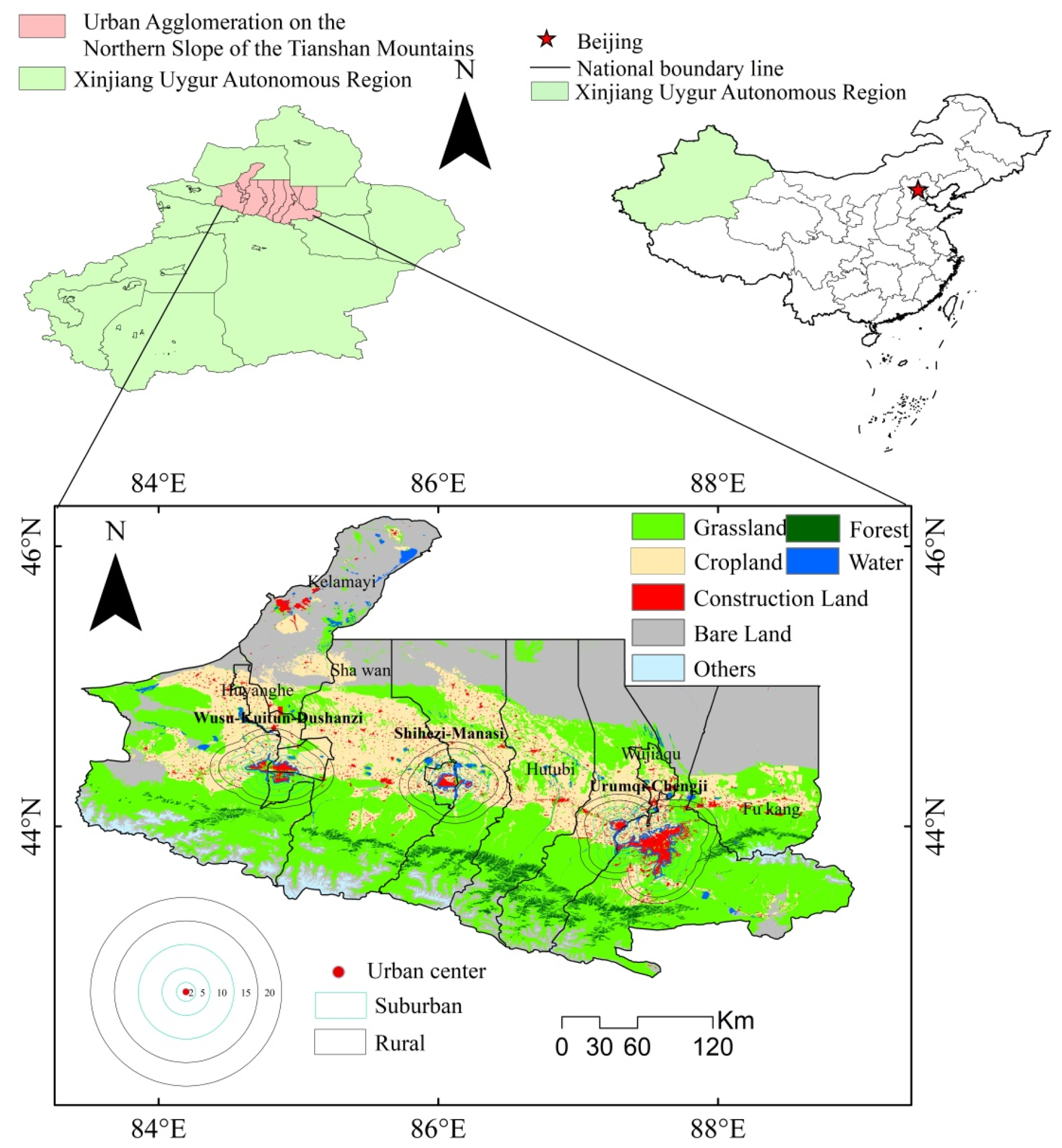

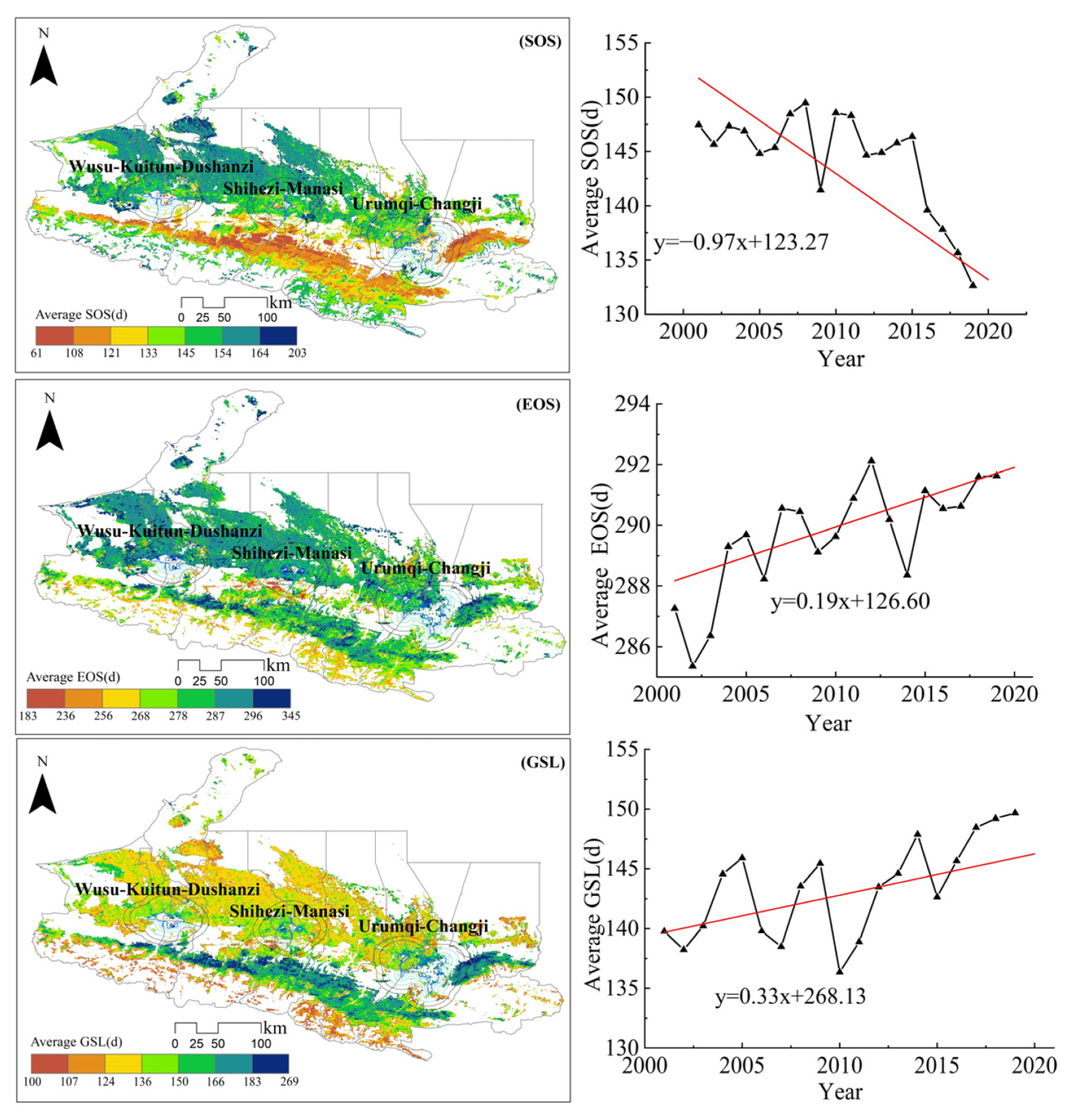

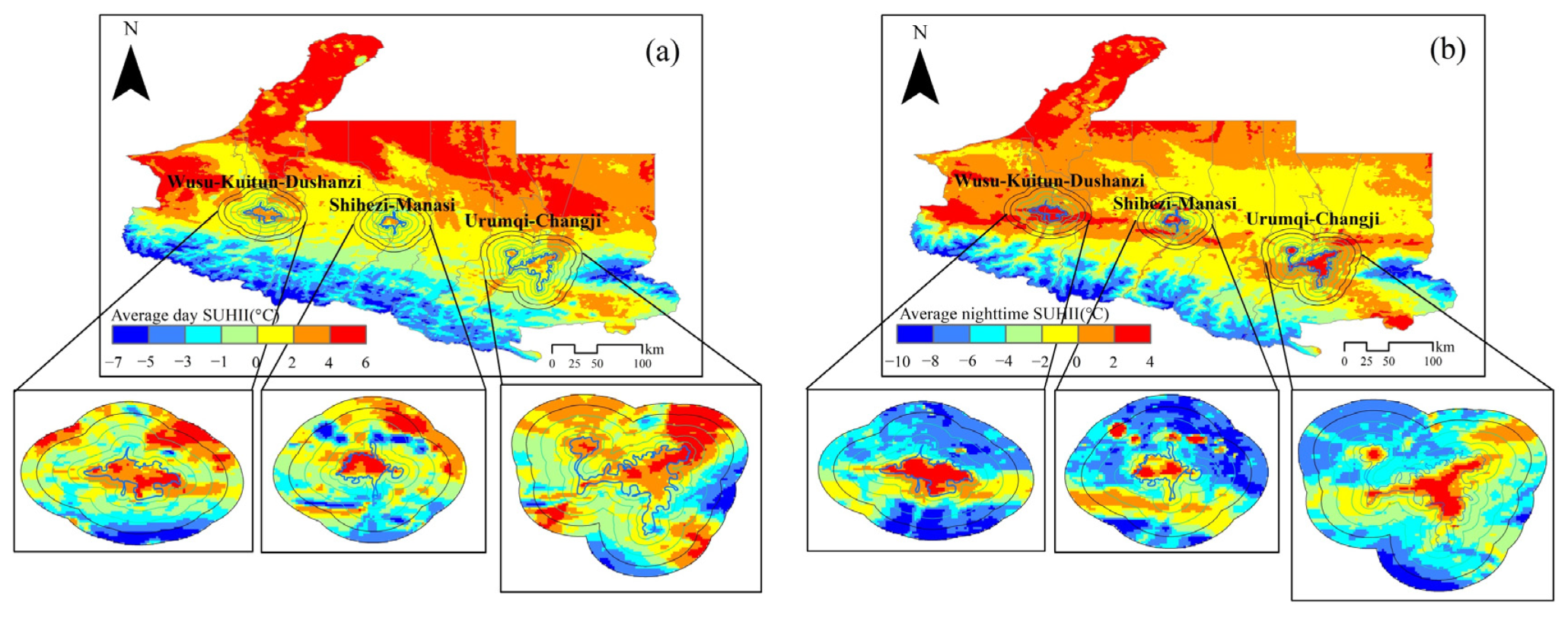
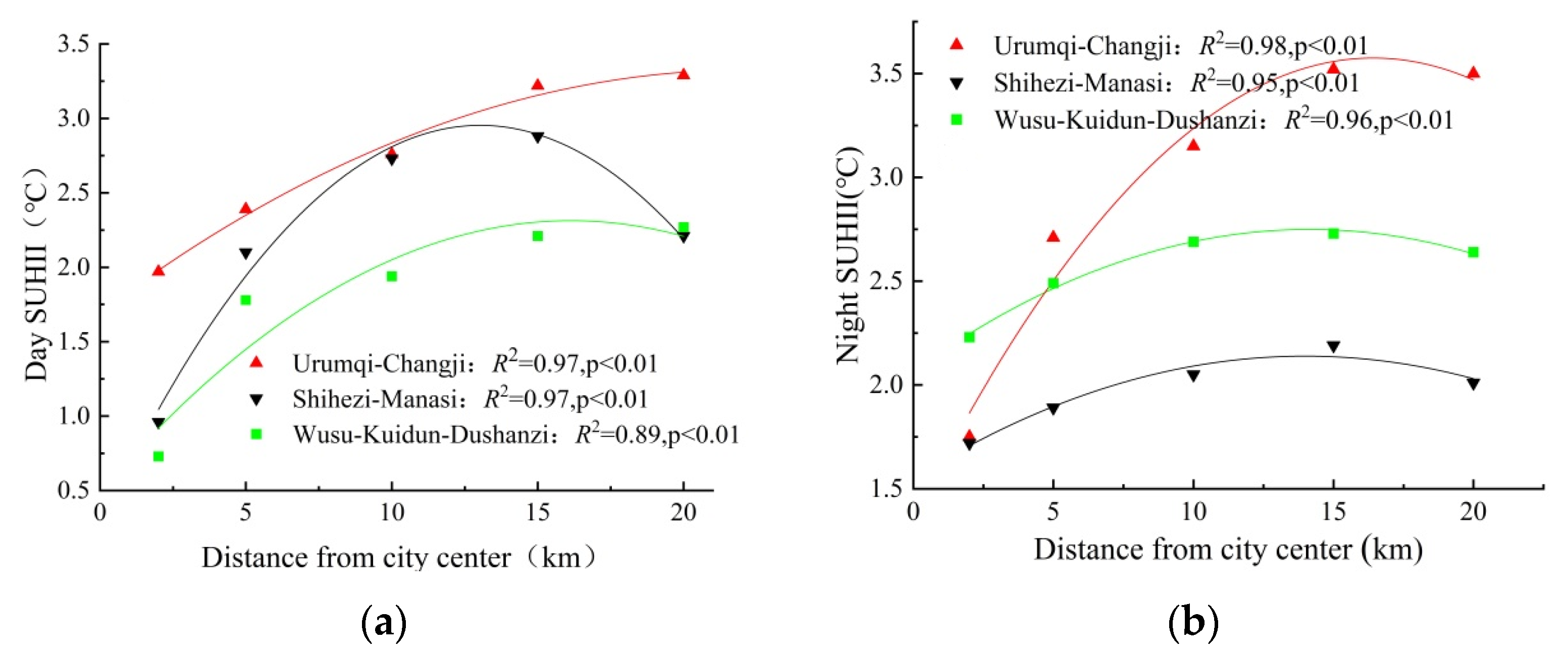

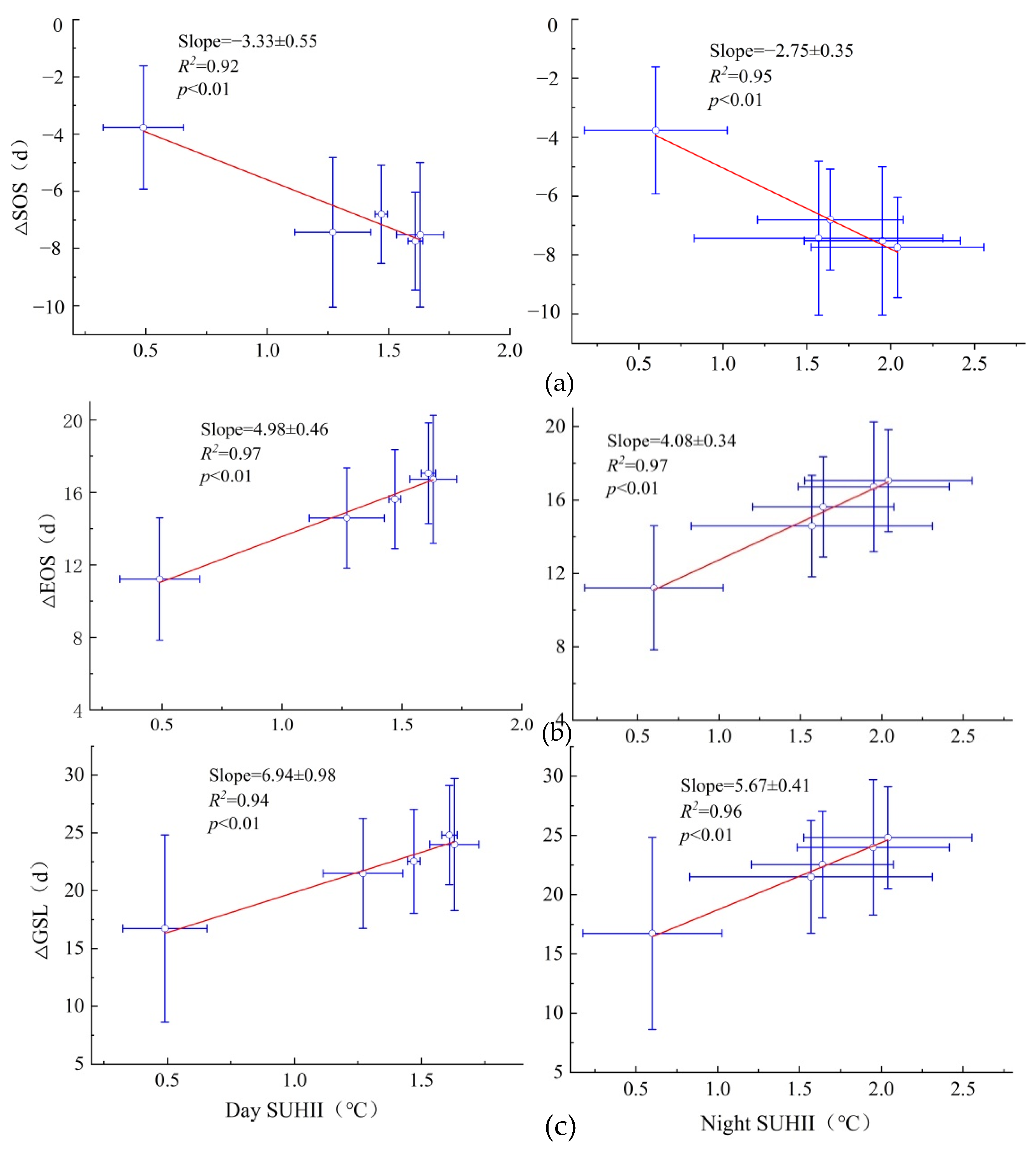
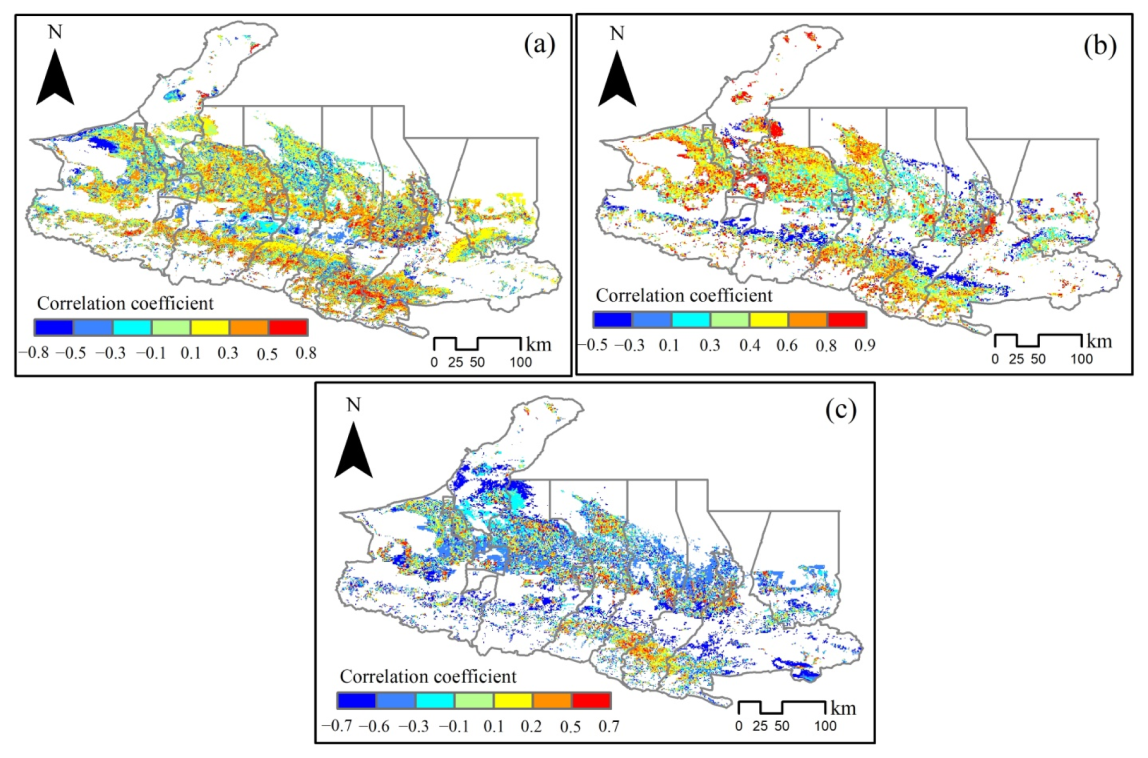



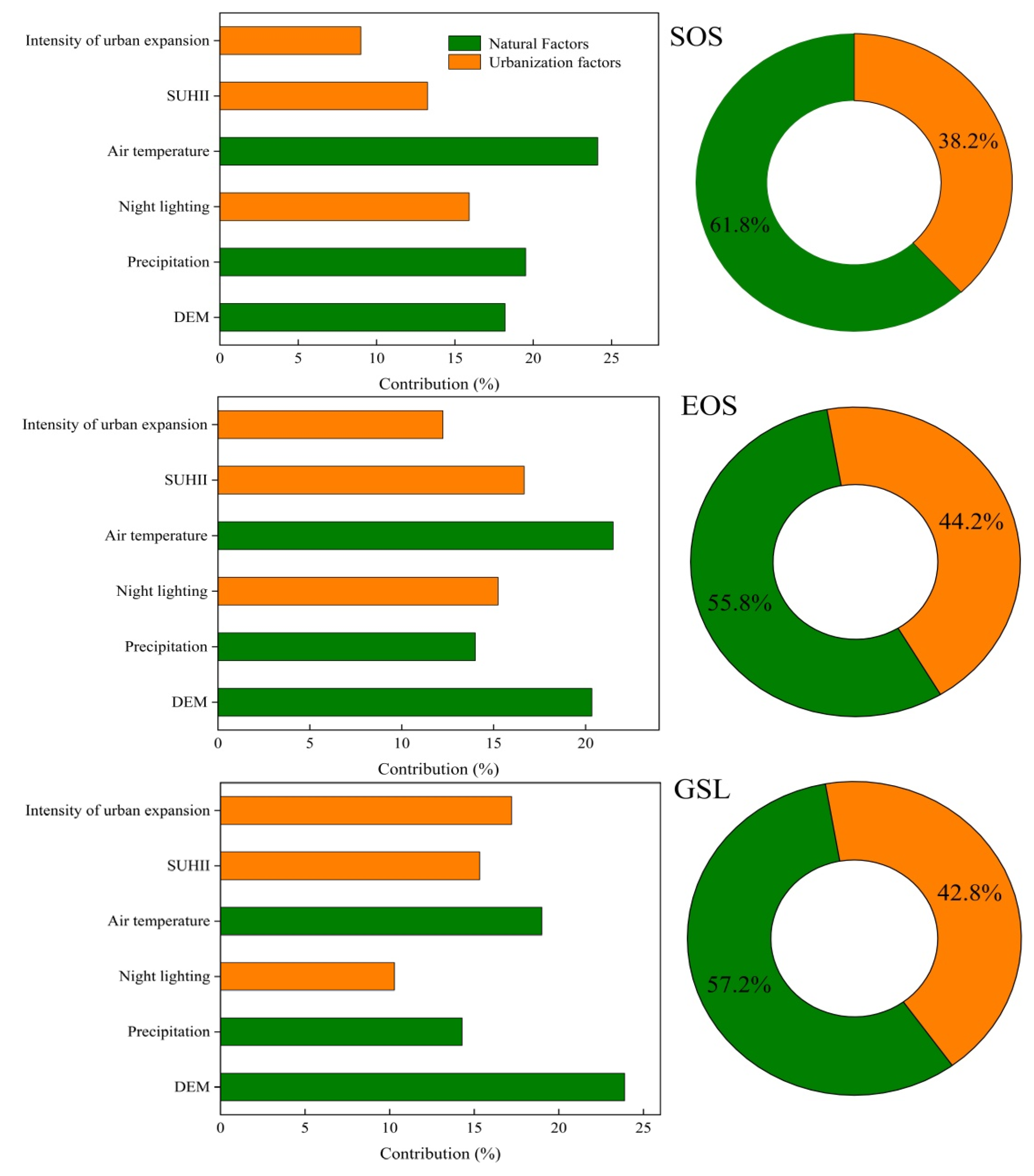
| Dataset | Data Source | Data Properties | Data Type | Time Coverage |
|---|---|---|---|---|
| MCD12Q2 | GEE | 500 m/yr | Greenup, Dormancy | 2001–2019 |
| MOD13Q1 | 250 m/16 d | EVI | 2020 | |
| MOD11A2 | 1 000 m/8 d | LST_Day_1 km, LST_Night_1 km | 2001–2020 | |
| Land-use type dataset | National Earth System Science Data Centre (http://www.geodata.cn/, accessed on 5 September 2020) | 30 m | grassland, cropland, forest land, water, construction land, and bare land | 2001, 2010, and 2020 |
| DEM | Geospatial Data Cloud | 30 m | ASTER GDEM V2 | 2020 |
| (http://www.gscloud.cn, accessed on 5 April 2023) | ||||
| Night-time lighting dataset | An extended time-series (2000–2020) of global NPP-VIIRS-like night-time light data (https://doi.org/10.7910/DVN/YGIVCD, accessed on 5 April 2023) | 500 m | — | 2001–2020 |
| Climate Data | National Earth System Science Data Centre (http://www.geodata.cn/, accessed on 5 April 2023) | 0.0083333° (approx. 1 km) | Precipitation, Temperature | 2001–2020 |
| Vector data | National Geographic Information Resource Catalogue Service System (http://www.webmap.cn, accessed on 5 April 2023) | — | Shapefile | — |
| City Cluster Name | Regions | SOS | EOS | GSL |
|---|---|---|---|---|
| Urumqi-Changji | urban centre | −0.85 ** | 0.83 ** | 0.81 ** |
| suburban area | −0.56 | 0.45 | 0.56 | |
| rural area | −0.74 * | 0.68 * | 0.57 | |
| Shihezi-Manasi | urban centre | −0.77 * | 0.69 * | 0.68 * |
| suburban area | −0.51 | 0.52 | 0.33 | |
| rural area | −0.61 | 0.63 * | 0.45 | |
| Wusu-Kuidun-Dushanzi | urban centre | −0.82 ** | 0.79 * | 0.74 ** |
| suburban area | −0.61 | 0.57 | 0.46 | |
| rural area | −0.63 * | 0.65 | 0.53 |
| City Cluster Name | ΔSOS/SUHII | ΔEOS/SUHII | ΔGSL/SUHII | |||
|---|---|---|---|---|---|---|
| Day | Night | Day | Night | Day | Night | |
| Urumqi-Changji | −0.87 | −0.94 | 0.98 | 0.95 | 0.96 | 0.98 |
| Shihezi-Manasi | −0.92 | −0.9 | 0.89 | 0.94 | 0.93 | 0.95 |
| Wusu-Kuidun-Dushanzi | −0.92 | −0.79 | 0.94 | 0.79 | 0.94 | 0.81 |
Disclaimer/Publisher’s Note: The statements, opinions and data contained in all publications are solely those of the individual author(s) and contributor(s) and not of MDPI and/or the editor(s). MDPI and/or the editor(s) disclaim responsibility for any injury to people or property resulting from any ideas, methods, instructions or products referred to in the content. |
© 2023 by the authors. Licensee MDPI, Basel, Switzerland. This article is an open access article distributed under the terms and conditions of the Creative Commons Attribution (CC BY) license (https://creativecommons.org/licenses/by/4.0/).
Share and Cite
Ahmed, G.; Zan, M.; Helili, P.; Kasimu, A. Responses of Vegetation Phenology to Urbanisation and Natural Factors along an Urban-Rural Gradient: A Case Study of an Urban Agglomeration on the Northern Slope of the Tianshan Mountains. Land 2023, 12, 1108. https://doi.org/10.3390/land12051108
Ahmed G, Zan M, Helili P, Kasimu A. Responses of Vegetation Phenology to Urbanisation and Natural Factors along an Urban-Rural Gradient: A Case Study of an Urban Agglomeration on the Northern Slope of the Tianshan Mountains. Land. 2023; 12(5):1108. https://doi.org/10.3390/land12051108
Chicago/Turabian StyleAhmed, Gulbakram, Mei Zan, Pariha Helili, and Alimujiang Kasimu. 2023. "Responses of Vegetation Phenology to Urbanisation and Natural Factors along an Urban-Rural Gradient: A Case Study of an Urban Agglomeration on the Northern Slope of the Tianshan Mountains" Land 12, no. 5: 1108. https://doi.org/10.3390/land12051108
APA StyleAhmed, G., Zan, M., Helili, P., & Kasimu, A. (2023). Responses of Vegetation Phenology to Urbanisation and Natural Factors along an Urban-Rural Gradient: A Case Study of an Urban Agglomeration on the Northern Slope of the Tianshan Mountains. Land, 12(5), 1108. https://doi.org/10.3390/land12051108








